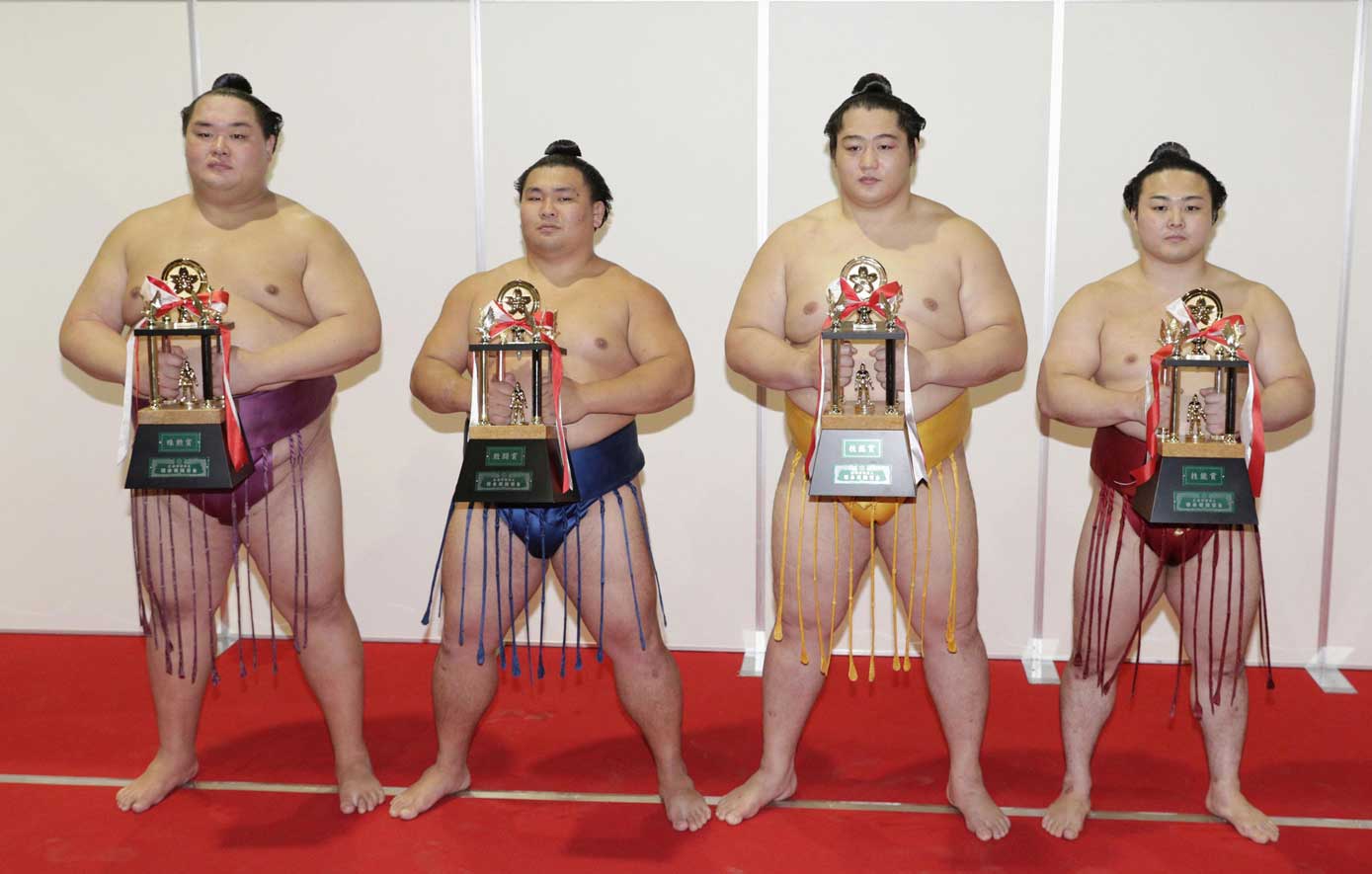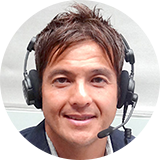Yokozuna showdown for the title

Entering the final day, Yokozuna Kakuryu was at the head of the pack with just 1 loss. He'd become champion if he could beat his rival Yokozuna Hakuho. Hakuho had 2 losses, and needed to beat Kakuryu to force a playoff. Their match turned into an exciting seesaw battle, as both Yokozuna came out with all guns blazing and refused to give in. It was power versus power, pride versus pride. After going after each other for 40 seconds, Kakuryu flexed his muscles and drove Hakuho back and out of the ring to claim the Emperor's Cup. It was Kakuryu's 1st championship in over a year, and his 6th overall.
During the victory ceremony, Kakuryu said that he was in really bad shape before the tournament, so it was unbelievable he ended up winning. He also expressed his gratitude to his fans by saying that he got results this time, thanks to the tremendous support he received from his fans in Nagoya. Kakuryu had never won a championship in Nagoya before, so he seemed really happy to win it this time.
I think Kakuryu's triumph was not only positive news for his fans but also for Kakuryu himself, because he seemed to have regained his confidence. The very next day after winning the championship, the 33-year-old Yokozuna left Japan for Mongolia to share the happy news with his family.
Hakuho comes up short
As for Hakuho, he got off to a fast start marking 8 straight wins from opening day, but let the Emperor's Cup slip out of his hands by failing to stay focused for the entire 15 days. On Day 9, his Mongolian compatriot Ichinojo caught Hakuho off guard to score a huge upset. And then on Day 14, the 35-year-old veteran Kotoshogiku snapped his 10-match losing streak against Hakuho by simply outmuscling him and forcing him out of the ring in a matter of seconds.

There's no question the two setbacks against these rank-and-filers cost Hakuho his championship in Nagoya. But I also think his physical condition was far from one hundred percent, although Hakuho said he had fully recuperated from his bicep injury. Both myself and the fans know that the 42-time champ is capable of fighting at a much higher level. Let's hope he gets himself back in much better shape for the next contest.
Woeful Ozeki quartet
The July tournament was missing many of its biggest stars, namely four Ozeki champions. First, it was Takakeisho announcing his absence citing his inability to compete with pain still lingering in his right knee. The 22-year-old seemed eager to take part in the 15-day meet. But his stable master refused to give him permission to do so and spent nearly four hours trying to persuade the young Ozeki to stay out this time to concentrate on fully recuperating. The stable master told Takakeisho he could jeopardize his pro career should he compete.

I think the master's decision to talk Takakeisho out of competing in Nagoya was a wise and correct decision, because had he taken part there was a chance he could've aggravated the injury and compromised his future in the sport. I will always remember what happened to Kisenoato when he returned to the ring before he was fully healed. His condition deteriorated and he had to retire early. Takakeisho is still young and I believe he'll become much better and stronger as soon as he gets his body in top form again. Takakeisho will be relegated from Ozeki to the third highest Sekiwake rank in September, but he still can return to Ozeki by scoring 10 wins.
On Day 6, Tochionoshin became the second Ozeki to announce his withdrawal, saying the pain in his right knee and left shoulder are intolerable. He had just returned to Ozeki in July, so the going will get tough for the Georgian Ozeki once again.
A couple of days later on Day 8, Goeido announced he would be absent from the tourney. He said he could no longer compete, because his right shoulder is not going to hold up any longer. Goeido ended the July tournament with 3 wins, 5 losses and 7 absences... a record far from something expected of an Ozeki wrestler. The long drought continues for Goeido, so he must regroup and return to relevance fast. His one and only top division championship was won way back in the 2016 September contest.
And, finally on Day 11, Takayasu said he'll be sitting on the sidelines for the remainder of the tournament due to a left elbow injury. Takayasu's absence meant that for the first time in modern sumo history, all four Ozeki were missing in action. Needless to say, it was so disappointing to see the entire Ozeki crew sitting out the tournament, because it really decreased the level of competition and also the excitement in Nagoya.
Asanoyama learns a lesson
Asanoyama was the winner of the previous tournament but he learned his lesson the hard way. After winning his first championship in May, he was boosted all the way up to Maegashira 1. His new rank meant that he'll be facing more rugged opponents from Day 1 to Day 15. As was projected by many sumo reporters and experts including yours truly, Asanoyama finished the tournament with a losing record. But he says he learned so much by going up against tough opponents on a daily basis. I have a feeling that Asanoyama will use this bittersweet experience to motivate himself and improve by working even harder. I'm positive that Asanoyama will redeem himself by coming back with a much stronger showing next time.

For Mitakeumi, it's time to shine
The wrestlers are divided into 5 different ranks in the top Makunouchi division, with the highest being Yokozuna. The top rank is followed by Ozeki, Sekiwake, Komusubi and Maegashira. Those two ranks below Ozeki; Sekiwake and Komusubi, are referred to as the Sanyaku. Making the Sanyaku once in your lifetime is every rikishi's goal, because Sekiwake and Komusubi ranks are so much more respected compared to a rank-and-file Maegashira.
Now, believe it or not, there's one wrestler who's been competing at the Sanyaku for 15 consecutive tournaments. He's Mitakeumi. Mitakeumi competed at the third highest rank of Sekiwake in July, and since he secured a majority of wins he will once again compete at the Sanyaku for the 16th straight time come the September contest. That stands as the second longest streak after former Sekiwake Wakanosato who fought at the Sanyaku for a record 19 consecutive tournaments.
On the one hand, competing at the Sanyaku for such a long period is an accomplishment in itself, but on the other hand it simply indicates your inability to move up to the next level -- Ozeki. To make Ozeki, you have to show consistency. Normally, you're required to score a double-digit winning record for three consecutive tournaments fighting at the Sanyaku to gain an Ozeki rank.

For Mitakeumi, this lack of consistency has held him back from earning the Ozeki promotion. Many fans are anxiously waiting for Mitakeumi to go over the hump and become Ozeki in the near future. And to me, the solution is plain and simple. Mitakeukmi is as talented as any wrestler I've seen in recent years and what he really needs is to train harder to make himself less vulnerable to drop the matches he should never lose. Right now, the 26-year-old's work ethic is not ideal for someone who's seriously vying to make Ozeki. So, if he can take a much more serious approach to his practice and work harder and hone his skills even further, his Ozeki debut will be just around the corner.
Special prize winners

A total of 4 men went home with special prizes.
First, Tomokaze was given the Outstanding Performance Award. He was the only man able to beat Kakuryu. The Fighting Spirit Prize went to Terutsuyoshi, who racked up 12 wins by relentlessly attacking throughout the tournament. Both Tomokaze and Terutsuyoshi are relative newcomers to the top division. Many have high hopes for the two youngsters to become next generation stars.
Endo took the Technique Prize. He dazzled fans with his aggressive forward charges and beautiful throws. Endo finished the contest with 7 straight wins to go 10 and 5. In September, he will more than likely get a boost up to the Sanyaku -- either to Sekiwake or Komusubi.
And the top division's smallest man, Enho, also won the Technique Prize for using nifty footwork and speed to defeat much bigger opponents. Enho, who weighs only 99 kilograms, was in tears when he scored a kachikoshi or majority of wins on Day 14, because it took him so long to finally finish with his first kachikoshi in the top Makunouchi division. Enho became the first man weighing less than 100 kilos to score a top division kachikoshi since Mainoumi in 1997.
The wily veteran hangs it up
One of sumo's most beloved and respected wrestlers called it quits during the July tournament. 40-year-old Aminishiki was competing in the second-tier Juryo division this time, but he was forced to sit on the sidelines after injuring his right knee once again on the second day. Aminishiki decided now is as good a time as any to announce his retirement, because his whole body, not just the knee, couldn't take it anymore.

Aminishiki is from Aomori prefecture in northern Japan and made his pro debut way back in the 1997 January tournament. The wily veteran competed in a total of 117 tournaments in the top two divisions, tying former Ozeki Kaio for the number 1 spot on the all-time list. He was known as an unpredictable and esoteric wrestler who was good at confusing his opponents. He ends his career having used a total of 45 different winning techniques... which is just shy of a record 46 held by former Mongolian wrestler Kyokushuzan.
Aminishiki will remain in the sumo association and will begin his new endeavor as a coach training younger wrestlers in his stable. Many are already visualizing Aminishiki becoming a great stable master in the near future, because the man knows the sport inside out.
The autumn tourney outlook
Finally, here's what to look ahead for in the next contest. The July tourney champion Kakuryu will try to make it two in a row and solidify his Yokozuna supremacy over Hakuho. Hakuho in the meantime will try to redeem himself and bring the Emperor's Cup back to his living room.
Takakeisho will be demoted from Ozeki to Sekiwake, but he'll be given a chance to regain the Ozeki status should he score 10 wins. Goeido and Tochinoshin must step up to the plate and score at least 8 wins respectively. Failing to do so will see them relegated to Sekiwake.
Personally, I advise fans to keep their eyes on the little go-getters, Terutsuyoshi and Enho, because they're so much fun and exciting to watch. Their outstanding performances make us realize that the lack of weight classes in sumo helps make it fascinating. It doesn't matter how big or small you may be, you fight the man you're told to fight.
The autumn tournament kicks off on September 8th in Tokyo.

